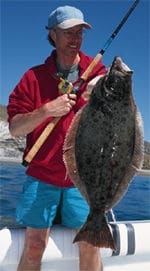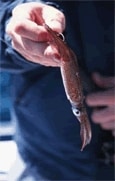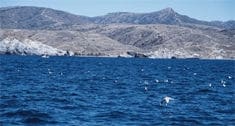
| Joe Hendricks shows off a halibut plucked from the sandy bottom off a Catalina beach. (left) Catalina’s fish-rich waters have long served as a beacon for SoCal anglers seeking a variety of hard-fighting game fish. |
The VHF radio was abuzz all day with chatter from private-boat anglers in search of white seabass at Santa Catalina Island. It was the height of the spring season for these big, prized croakers, but on this day they were not cooperating.
From my vantage point outside West Cove on the backside of the island, I could see at least 20 boats anchored close to shore, all hoping to intercept a school or two of whites as they cruised the beach. As patience waned, the fleet gradually scattered to other parts of the island in search of more productive shorelines.
All the while, however, my crew and I had been catching fish after fish, less than a quarter-mile from the fleet. So intent was the focus of the seabass anglers that they overlooked outstanding fishing for yet another prized game fish – California halibut.
Home of the Halibut
Located off the coast of Southern California, Santa Catalina Island is famous in fishing circles for many reasons. Acknowledged by many as the birthplace of big-game fishing, Catalina has attracted anglers since the turn of the last century. An abundance of striped marlin, bluefin tuna, yellowtail, swordfish and giant seabass has earned Catalina a legendary reputation. There’s also calico bass, and more recently white seabass have rebounded in the waters around the island, adding to Catalina’s allure.
Yet mention halibut and most anglers think of Santa Monica Bay or the more northerly Channel Islands. Few people associate Catalina with halibut, which is just fine with the cadre of private-boat anglers who know that these waters offer some of the finest flatty fishing on the entire coast.
“There have always been halibut at Catalina, but the best fishing was fairly seasonal,” says Mark Wisch, who has fished the island for more than 30 years. He notes that the best months were always March, April and May, although this has changed in recent years.
“The fishing has been consistently good throughout most the year,” he adds. “Not many guys are targeting them.”

Halibut fishing at Catalina has taken off in recent years, thanks in large part to California’s inshore net ban. Now anglers can catch these great-tasting flatfish year-round.|
There are at least two reasons for the boom in halibut fishing. One is the elimination of inshore gillnets more than ten years ago with the passage of Proposition 132, the nation’s first law banning the use of such commercial fishing devices. The second factor is squid. In recent years, opalescent squid have returned to the island to spawn in staggering numbers. Schools are not only massive, they also seem to linger in the vicinity of Catalina for several months – some years arriving in fall and not departing until early summer. Good halibut fishing often coincides with the squid runs.
The abundance of squid also attracts schools of yellowtail and white seabass, as well as the anglers who pursue these glamour species with fanatical zeal. In fact, they can be so obsessive in their search that they either ignore or are oblivious to the outstanding halibut action that’s available.
Some anglers, however, capitalize on both the visiting “exotics,” as well as halibut. They do so by fishing for white seabass or yellowtail in the early morning and late afternoon, and focusing on halibut during the middle of the day.
While halibut fishing at Catalina seems to be getting better, size is a different matter. Unlike halibut found close to the coast and around the more northerly Channel Islands, the Catalina fish do not seem to grow larger than 20 pounds. Instead, fish in the six- to 12-pound range are more common.
However, some believe that the average size of halibut caught at Catalina will gradually increase as the population more firmly establishes itself at the island and the fish mature. In the meantime, Catalina flatties make up for any lack of size by offering consistent action – if you can find the fish.
In-Depth Knowledge

A live or dead squid hooked through the mantle and fished on the bottom is a deadly bait for Catalina ‘buts.|
Halibut seem to congregate on the bottom at a certain depth around the island. The key is to find that depth, which can vary from 120 feet to just outside the shore wash.
The presence of squid – usually squid that have died the night before and settled to the bottom – is what determines the location of the halibut. Squid spawn at night in deeper water, usually around 120 feet. When currents run parallel to or away from the island, pushing the fresh-dead squid along the bottom, halibut tend to bunch up in deeper water. However, when currents sweep into the island, halibut move closer to shore to feast on the easy bounty. Consequently, knowing where schools of squid were located the previous night is an important clue to locating halibut the next day.
Zeroing in on the squid is usually not difficult, at least not during the week. When the squid are running, commercial “light boats” are often on the squid grounds at night and the next morning, harvesting the tasty calimari. In fact, some will sell live or fresh-dead squid to private-boaters to use as bait. On weekends, however, commercial fishermen are prohibited from harvesting squid, which can make it harder to find the grounds. However, the signs are there if you know what to look for.
Flocks of gulls sitting on the water and an abundance of sea lions are tip-offs to the presence of squid below. Another sign is an extraordinary number of blue sharks in the area. All of these creatures zero in squid. A few passes through the area with a fishfinder can confirm things (squid schools register as light blue on a color sounder). Even if you don’t mark any squid schools on your fishfinder, it often pays to work the area. The live squid may have departed, but the ones that died the night before may still litter the bottom.
Simple Rigs

Catalina’s fish-rich waters have long served as a beacon for SoCal anglers seeking a variety of hard-fighting game fish.|
Once you find the squid grounds, start fishing. The terminal rig is simple. Most anglers pin a 3/0 hook through the tip of a squid and use a sliding egg sinker ranging from 1/2 to three ounces in weight, depending on depth, current and drift speed. As with all flatfish, the idea is to keep the bait on the bottom, where halibut do most of their feeding.
If you are drift-fishing, tie a barrel swivel to the line about 24 inches above the hook, yet below the egg sinker. Squid tend to spin more than finned baits such as sardines, and the swivel will help prevent a tangle. It also keeps the weight away from the bait, which some halibut fishermen feel helps increase the number of bites.
While Catalina halibut do not require anything more than 12- or 15-pound tackle, there is a strong possibility of hooking a yellowtail or white seabass among the flatties. Therefore, I prefer to fish with 25- or 30-pound gear. The heavier line does not seem to deter halibut from taking a hooked bait, especially when they are feeding on squid. At the same time, you will be prepared for a big ‘tail or seabass.
When fishing deep for halibut, I like a fast-retrieve reel with at least a 6:1 gear ratio. This lets you tighten the line quickly before setting the hook.
Big Bunches of ‘Buts
| ## Halibut RegsThere are both size and bag limits on California halibut. To be a keeper, a fish must be at least 22 inches long, measured from the end of the tail to its snout with the mouth closed. Also, in Southern California waters, the daily bag limit is five fish per licensed angler. North of Point Sur in Mendocino County, the daily bag limit drops to three.Regulations also require boat anglers to carry a landing net with a hoop that measures at least 18 inches in diameter for boating fish of questionable size. Many anglers today are also using “halibut friendly” landing nets with very fine mesh. This helps prevent the tail-splitting injuries that larger mesh can inflict. If infection sets in, these wounds can be deadly.Finally, for more substantial fish – halibut in the 15- to 40-pound range – you will need a sharp gaff. A gaff hook with a three-inch gap seems to work best.- Jim Hendricks |
You will often find halibut bunched up in a relatively small area. They may be concentrated along a little beach, a gravel slide or in a bottom depression in deeper water. For this reason, it’s important to note where each bite occurs. While drifting, use GPS to record the location of each bite. When closer to shore, you can use landmarks and depth readings from a fishfinder. Often a pattern will emerge, and you can then focus your efforts on the most productive zone.
It’s also important to note when the fish are biting. Halibut feed more actively on a moving tide, and the flood seems to be most productive, especially when the fish are close to the beach. If you catch only one or two fish at slack tide, try the area on a rising tide and you may have more action.
Finally, be aware that there may be other species of flatfish feeding among the halibut, especially in deeper water. These include rock sole and sanddabs, two smaller but equally tasty cousins of the halibut that also home in on squid.
Catalina is truly an island of wonder for fishermen, and it’s easy to see why the pursuit of the so-called “glamour species” often consumes all of one’s angling energies. However, the next time you can’t get the white seabass, yellowtail or calico bass to bite – or simply want to catch something different – remember the island’s burgeoning halibut fishery. It could flat out make your day.









